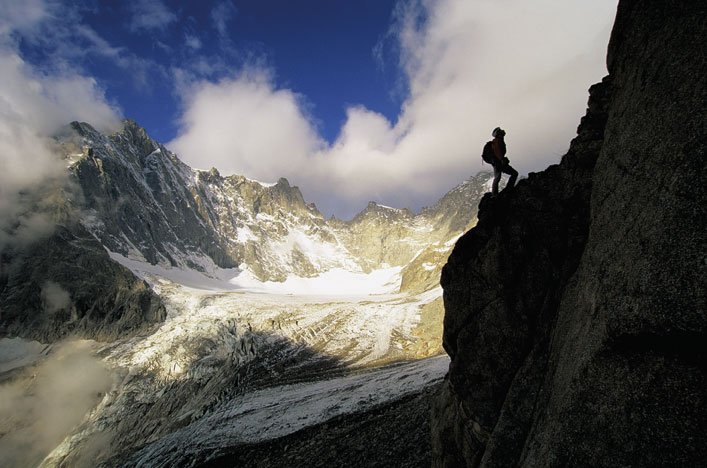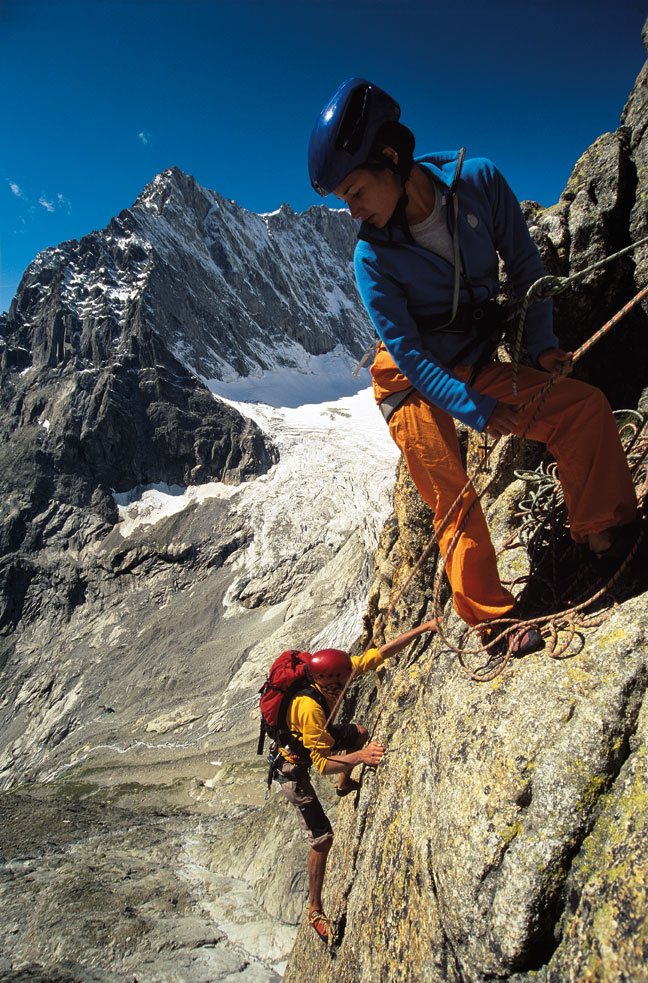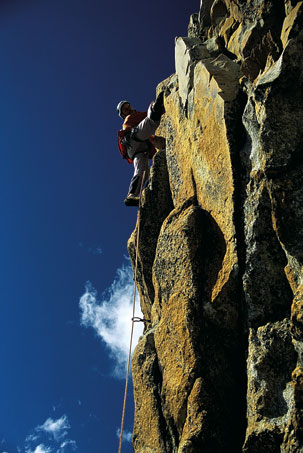


Monts Rouges du Triolet
Dalmazzi, the law of silence
Only revealed in 1997, the climbing fraternity in the Red Mountains of the Triolet has, after ten years, retained all its discretion. Situated just above the Dalmazzi refuge, it offers a rare selection of long equipped itineraries on perfect granite. Hush though! Don’t talk about it too loudly, they might hear you.
Text and photos: Guillaume Vallot
How can a whole face of the most frequently visited massif in the world have been able to remain virgin territory until the start of the 1990s? This was the jubilant question which a handful of climbers must have pondered in 1993, on discovering the virgin cirque on the southern slope of the Triolet. This granite basin of perfect granite is situated at the bottom of the Val Ferret, just behind the Mont Blanc tunnel.
The âDalmazzi mysteryâ perhaps stems from this: for five cable cars on the French side, the Italian slope of Mont Blanc has just one. Moreover, the Red Mountains of the Triolet harbour an abundance of deposits of precious crystals, which may have prompted the cultivation of a taste for secrecy. In 1981, a regional law ended up prohibiting the extraction of minerals in the upper Aoste valley. A certain humility associated with the area becomes even more evident when you note the surprising lack of information about these fine walls in French speaking reports. You can’t find anything on them in â100 Plus Bellesâ (The 100 finest) by Rébuffat in 1973, only the bare minimum in the âGuide Vallotâ in 1987 and nothing at all in the exhaustive âNeige Glace et Mixteâ by Damilano and Perroux...
A closed fist over its treasures
Pick the topographical map on a scale of 1/25,000 and place your right hand on the Triolet glacier, palm upwards, fingers pointing to the north-west. Close the fist. With the thumb on the Aiguille de Triolet, the long ridge of the Red Mountains runs perfectly along the side of your wrist. To the north, the Pointe Isabella, the Aiguilles de Savoie and Talèfre perfectly delineate the folded index finger, middle finger and ring finger. The Triolet cirque is just like a closed fist! Nevertheless, it is in no way a remote place and it isn’t at all complicated to get there. Between Courmayeur and the tunnel of Mont Blanc, it is sufficient to traverse the Val Ferret all the way to the terminus. At the end of the route, the Col Ferret piste begins and then switches across to Switzerland where there is L'A Neuve and La Fouly. A track rises up towards the severe cross cliff of the glacier and the Dalmazzi refuge path runs along the edge. The first climbing route then appears after just 40 minutes’ walking!
The cirque of unscalables
Facing the French slope, the Italian slope contains a very slim list of routes. The main summits of the cirque have, without exception, been conquered via the other side. The first notable ascent only dates from August 1913. Solo climber Paul Preuss comes and straddles the middle finger of the closed fist: the very pure south-east ridge of the Aiguille de Savoie. At the end of the 1930s, the big heroic names of alpinism come here to work the last north faces. In 1937, Boccalate has it out with Greuvetta, âone of the highest and most secret north faces of the massifâ according to Piola. In 1939, Cassin and Tizzoni opt for a severe direct route at the Aiguille de Leschaux. As for the three kilometre red granite ridge, for decades it attracted only the crystal gatherers.
In his revolutionary report guide, which came out in 1993, Michel Piola nevertheless touches on a few timid adjectives: an approach hike which is ‘not as terrible as all that’, a ‘surprising’ discovery, ‘fine rock’… But there was nothing at that point to give any indication of how a handful of granite enthusiasts suddenly fell in love with the area. The talented Swiss climbers Romain Vogler and Michel Piola, the French climber Patrick Gabarroux as well as the inexhaustible geometrician Manlio Motto, decided to cross the Red Mountains of the Triolet on a regular basis…and above all keep the spot secret! In four years, no less than 50 itineraries would be opened and equipped with the utmost discretion. At the end of 1996, in Chamonix and Courmayeur, rumours were rife and, at the start of 1997, it formed the basis of a scoop in the magazine Vertical where the small group finally displayed the information.
The routes stretch for up to 20 pitches with difficulty levels ranging from 4 to 7, and the approaches range from 5 minutes with special shoes designed for walking on snow, to 2 hours in crampons. It’s hard to get more variety! Alongside the difficult itineraries, you can find the ‘all inclusive’ equipped routes and a few homogenous jewels with a 5c/6a entrance ticket. You simply must tackle one of the two ‘top of the bill’ climbs that are âChamois Volantâ and âKermesse Folkâ : 750 metres, 19 pitches between 4a and 5c or even the fabulous âProfumo Prohibitoâ, a 270 metre red buttress and aerial section, which doesn’t exceed 6a. These three introductory ideas will act as an appetiser and make you keen to return to this remote corner which, decidedly, is well worth a visit.
Read the rest of the article in the Mountain Report magazine - Where to find ?
